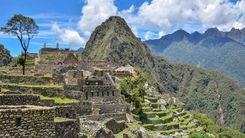The Ausangate Circuit explores the Cordillera Vilcanota, weaving around many peaks over 6000m. Ausangate, the highest peak at 6384m, remains at the hub of the standard trail. Many of the camps are over 4600m and there are two passes over 5000m to be tackled. A good map is essential – the best is the PERU Topographic Survey 1:100,000 – 28-T, available from the South American Explorers’ Club – and a local guide strongly recommended. The management at Tinqui’s Hostal Ausangate can arrange guides, mules and a muleteer (arriero). Some supplies are now available at the trailhead, but it’s still safer to bring everything you need with you; there’s more choice in Cusco, but some food and cooking utensils could be purchased en route in Urcos.
The first day’s uphill walking from Tinqui brings you to a natural campsite on a valley floor almost 4500m above sea level close to the hot springs near Upis with tremendous views of Nevado Ausangate. Day two requires about six hours of walking, following the valley up and over into the next valley through the high pass of Arapa (4800m) heading for the camping area at the red-coloured lake of Laguna Jatun Pucacocha; from here you can see and hear the Nevado Ausangate’s western ice-falls against a backdrop of alpaca herds.
Day three tackles the highest of all the passes – Palomani (5170m) – early on. From here there are views over Laguna Ausangatecocha, and the walking continues up and down, passing the Ausangate base camp en route. From Palomani it is three or four hours’ walk to the next campsite, offering some of the best views towards the glaciated peak itself.
Day four continues downhill towards the Pitumarca Valley, which you follow left uphill to a campsite beyond Jampa, a remote settlement way beyond the electricity grid, but just this side of the magical Campa Pass (5050m), where centuries’ worth of stone piles or cairns left by locals and travellers adorn the landscape honouring the mountain god. From here there are spectacular views towards the snowcapped peaks of Puka Punta and Tres Picos.
Day five takes you uphill again through the pass and down beside Lake Minaparayoc. From here it’s a three- or four-hour descent to the campsite at Pacchanta where there are some welcoming hot springs, traditionally enjoyed by trekkers as they near the end of this trail. Beyond Pacchanta, it’s another three-hour walk back to Tinqui for road transport to Cusco.



